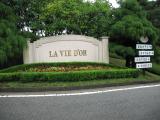

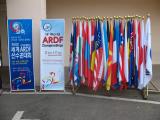
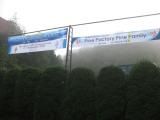
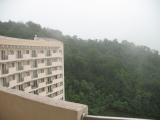
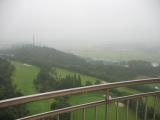
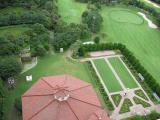
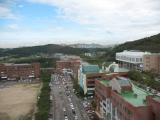
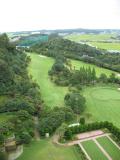
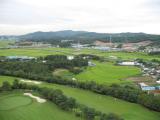
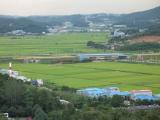
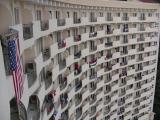

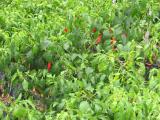
Jen and I attended the 14th World Amateur Radio Direction Finding Championships, September 2-7, 2008, in Hwaseong, Korea. It was the first world championships to be held in Korea, and only the second to be held in IARU Region III. Korea has the fourth largest amateur radio population in the world, with about 140,000 licensed operators.Jen was a competitor in the W21 (women, any age) category, and I was an international juror.
These photos are copyright © 2008 Kenneth E. Harker. All rights reserved.
The meet headquarters was located in a hotel in Hwaseong, Korea. Hwaseong is a city in Gyeonggi province, south of the national capitol of Seoul. About 360,000 people live in Hwaseong, many of whom commute into Seoul for work. There are some major employers in Hwaseong, including Samsung Semiconductor, Kia Motors, and Hyundai. The city limits of Hwaseong incorporate a much larger area of land than the city limits of Seoul itself, but most of Hwaseong is very rural. Our hotel was located on one of many country roads well outside of the city center of Hwaseong. The meet headquarters hotel was the La Vie d'Or Country Club and Resort. The hotel was apparently founded as a country retreat for pensioners, and has a nine-hole golf course. It seems like most of the guests now must belong to conferences and groups. The hotel had many flaws, but there may not have been many alternatives in the area that could handle groups with 450 people at once.
 |
The La Vie d'Or entrance sign. It was raining on the day we arrived. |
 |
The hotel was near the top of a steep hill. |
 |
Banners and flags at the hotel entrance. There were 31 flags for the 31 countries represented by competitors, officials, and observers. As it turns out, two of the teams didn't make it after all - but their flags were there nonetheless. |
 |
Some more banners outside the front entrance of the hotel. These changed as different groups arrived and left during the week. |
 |
We had a room on the 19th floor. This was the view from our balcony, looking at the hotel and the woods behind it. |
 |
In the rain and fog, you couldn't even see across the little valley we were in. You could only see one hole of the golf course from our room. The green fields on the far side of the road are rice paddies. |
 |
The hotel had a garden patio where we had several dinners during the week (not in the rain, of course). |
 |
By Tuesday, September 2, the rain had stopped. This is a view from the elevator lobby. In the foreground is the campus of Suwon Science College. It is affiliated with the University of Suwon, and it seemed like all of the students arrived and left via University of Suwon buses or city buses. I think it is a two-year technical school. The dirt field on the left was a soccer field. Every soccer field we saw in Korea was dirt, not grass. In the distance are the high rise apartment buildings of Suwon City. |
 |
Some more views from our room. In the distance, you can see some tall netting behind the trees. Driving ranges, or "net golf" as we saw it called in several other locations, were common in the suburbs of Seoul. |
 |
A better view of the small valley in which our hotel was located. The country road going through the middle of the photo is the road upon which the hotel and the college were located. |
 |
A view farther out in the valley. As you can see, most of the buildings are located on the hillsides, and the flat valley floor is devoted to agriculture. |
 |
Another view of the hotel itself from our balcony. During the week we were there, a wide variety of international flags and orienteering clothing (set out to dry) would hang from the balcony railings. The American flag belonged to one of our teammates in the room next door. |
 |
The day we arrived, we went down to the country road for a lunch of kimchi jjige, a spicy stew of pork, cabbage, and chili peppers. There were maybe half a dozen restaurants and as many shops in a ramshackle collection of run-down buildings along the road. This field of peppers was between a FamilyMart franchise convenience store (the nicest store on the street) and a used tire store. The sidewalk was an unusual feature - we did not see many outside of the city center. The building on the hill in the background is part of the Suwon Science College. |
 |
Korean chili peppers. The chili is a plant native to the Americas, and was first introduced to Korea in the early 17th century, shortly after Portuguese traders brought the chili pepper to Nagasaki for trade with the Japanese. The Japanese did not really appreciate it, but the Koreans have embraced the chili wholeheartedly. |
Wednesday, September 3, was the practice day. On the practice day, the organizers put out transmitters that are identical to the transmitters that will be in the field on the competition days. They are placed in a smaller area than the area in which the competition days will be held. Competitors are given a map of the area and can use the opportunity to familiarize themselves with the kind of terrain they will encounter on course. The practice day is also an opportunity to test and adjust the radio receiver gear for optimal performance. We discovered a few useful points of information this way: the transmitters that the Koreans used were louder on 80 meters than what we in the USA were used to, and the maps were not likely to include some man-made objects, including fences.
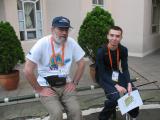 |
Dale Hunt WB6BYU and Jay Thompson W6JAY, waiting near the hotel entrance in the morning. Dale was the USA Team Captain. He had planned to run in the M50 (men, ages 50 and older) category, but was recovering from a recent foot injury, so he spent his time looking after the interests of Team USA instead. Jay ran in the M21 (men, any age) category. Jay is holding a receiver for 144 MHz. Both Dale and Jay have their laminated identification cards around their necks. |
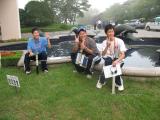 |
Some members of Team Japan, waiting for the buses. The fountain they are sitting on was turned off during the night and had not yet been turned on that morning. I don't know what the small sign says - probably "keep off the grass". |
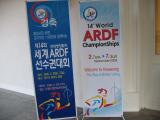 |
A closer view of the banners by the hotel's front door. |
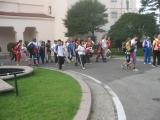 |
At some point, someone tells us all that the buses are at the bottom of the hill, so everyone starts walking in that direction. Some of the competitors are dressed in their national uniforms, others are wearing more casual outfits for the practice day. |
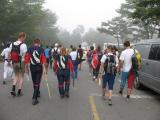 |
It was a misty morning, but plenty warm. Every day we were there, the daily high temperature was in the mid-80s Fahrenheit, with high humidity. |
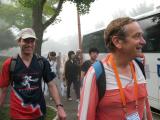 |
In the coral colored jersey, Jay Hennigan WB6RDV looks for the USA bus. The organizers allocated each bus to one or more countries. I think this helped the organizers make sure that nobody was left behind, as they could rely upon the team captains to report that everyone was present and accounted for. The USA and the Ukraine shared one bus. In the blue jersey is Bruce Paterson VK3TJN, who turned out to be on a different bus that was shared by four countries with smaller teams. |
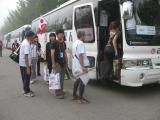 |
Team Japan brought enough people that they had their own bus to themselves. |
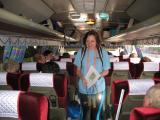 |
Nadia Scharlau getting on the bus. Nadia ran in the W35 (women, ages 35 and older) category. Nadia won a bronze medal at the 2006 World Championships in Bulgaria - the first American to medal at a world championships. Nadia had a more difficult time in Korea - she would finish 15th on 144 MHz and 9th on 3.5 MHz. |
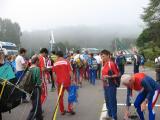 |
Everyone unloading from the buses at the practice area. Most people carried their 144 MHz receivers in hand, and brought their 3.5 MHz receivers in bags or backpacks. |
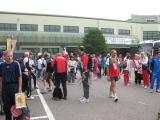 |
Competitors from all over the world mingle in the parking lot. |
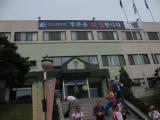 |
The practice area was the Gyeonggido Shooting Range in Hwaseong, which included both indoor and outdoor ranges. It was the venue for the 2002 Shooting World Championships. We never went into the building. A target practice area behind the building was marked as "dangerous, off-limits" on the practice area map. I never heard gunfire while we were there, so I assume there was no outdoors shooting during our visit. |
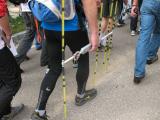 |
For 144 MHz, most competitors used three-element yagis. This receiver employs a four-element yagi. |
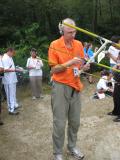 |
One of two competitors from Great Britain, David Williams M3WDD is tuning his ROX-2T receiver to find the 144 MHz transmitters. David is one of the authors of Radio Orienteering: The ARDF Handbook, the only English-language book published so far that focuses exclusively on ARDF. |
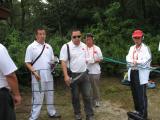 |
Members of Team China in the practice area. Team China apparently found corporate sponsors for their team, as they all wore team uniforms that included the logo of Shenzhen HYT Science and Technology Company, a major domestic supplier of radio transceivers in China. |
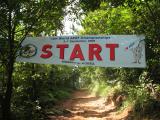 |
The start banner in the practice area. This same banner would be used on both competition days. |
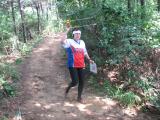 |
A member of the Czech Republic team, practicing on 144 MHz. Her receiver incorporates only two elements to create a directive pattern. |
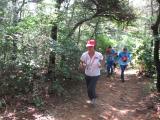 |
A Chinese runner coming up the trail. She is holding an 80 meter receiver, probably a PJ-80, based on a ferrite rod antenna design. Ferrite rod antenna designs allow for lighter-weight, more-compact receivers, but are not quite as sensitive as magnetic loop receiver designs. |
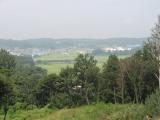 |
A trail in the practice area followed the top of a ridge, and offered great views. |
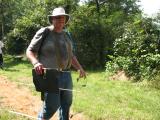 |
Scott Moore KF6IKO, heading down the trail to get his other receiver for more practice. Scott was one of the Team USA runners in the M40 (men, ages 40 and older) category. |
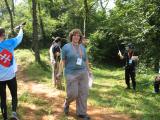 |
Jen Harker W5JEN, on the trail during the practice. Jen is holding a 144 MHz rig made from a VK3YNG Foxhunt Sniffer Mark IV receiver and a home-made WB2HOL tape measure yagi. |
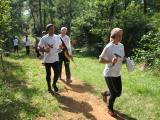 |
Runners from a variety of countries. The gentleman with the 144 MHz receiver in the center of the photo is wearing the team kit of Germany. |
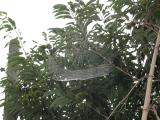 |
A big spider web, probably a meter across. We saw some very big spiders in the woods. |
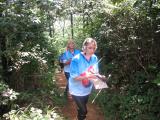 |
Three women from Team Slovakia climb up a steep trail. |
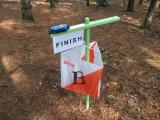 |
The control flag and electronic punch for the finish beacon on the practice day. The championships used SportIdent electronic timing devices. All of the controls used steel stands just like this. |
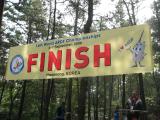 |
The finish banner. |
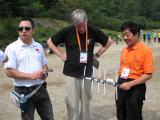 |
Wang Lijun BD1OO from China (left) was promoting the products of the Beijing TopRadio Science and Technology Company. Here he is showing two of the international jurors, Rainier Floesser DL5NBZ (center) and Chen Ping BA1HAM (right) an ARDF receiver designed for 433 MHz, a radio frequency that is not frequently used for recreational direction finding outside of China. |
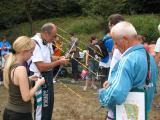 |
Members of Team Slovenia. |
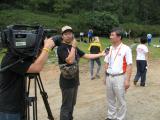 |
The local media showed up for the practice. In addition to filming at some of the practice transmitters, they interviewed the organizers. Han Jeong Hoon HL2AGG, the President of the Korean Amateur Radio League, is preparing to answer questions for a television news reporter. |
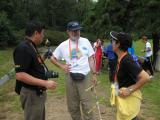 |
Dale Hunt WB6BYU discusses the event with two IARU Region III observers. Lim Kean Chuan 9M2LC, on the left, came from Malaysia, and Thida Denpruektham HS1ASC, on the right, came from Thailand. Thida has persuaded Region III to allow her to host the 2009 IARU Region III ARDF Championships in Thailand. Thailand has the third largest amateur radio operator population in the world. |
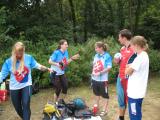 |
The team kit for Slovakia was very distinctive. The national coat of arms includes a double cross above three mountain peaks. |
The opening ceremony for the championships was held at the University of Suwon (which is actually located in Hwaseong, not Suwon) - about a 25 minute bus ride from the hotel. The main ceremony took place indoors in a big performance hall, while outside they had a special event amateur radio station. In the performance hall, everyone was provided with special FM radios that could receive a live English-language translation of the few parts of the show that were only in Korean.
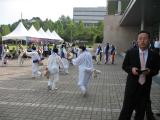 |
Drummers and dancers greeted everyone as we file into the performance hall. |
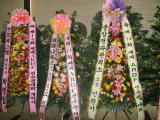 |
These floral arrangements were inside the lobby of the performance hall. |
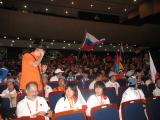 |
The performance hall begins to fill up with competitors, observers, and officials. Every team brought along their national flag for the ceremony. |
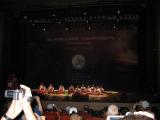 |
The program started with some traditional Korean folk music performed by women wearing traditional hanbok. |
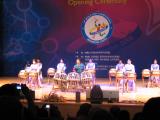 |
The next performance was by some very high energy traditional Korean drummers that I thought were fantastic. |
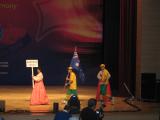 |
Next, came the parade of nations. Each country sent up to two team members with their national flag across the stage. In the case of Australia, that was the entire team. Bryan Ackerley VK3YNG is carrying the flag, while Bruce Paterson VK3TJN follows. |
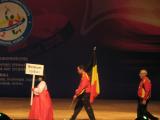 |
Team Belgium brought five competitors to the championships. Every team had a banner with its name (in English) and IARU member society abbreviation on it carried by a woman in traditional hanbok. |
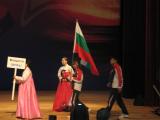 |
Team Bulgaria. The 2006 World ARDF Championships were held in Primorsko, Bulgaria. |
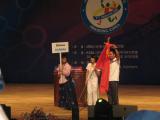 |
Team China was one of the larger delegations, with 16 competitors and 13 others, including trainers, jurors, and visitors. |
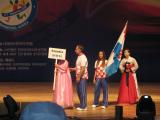 |
Team Croatia. The red and white checkerboard pattern on the team kit made them easy to identify in the woods. Croatia is set to host the 2010 World ARDF Championships, in the seaside resort town of Dubrovnik. |
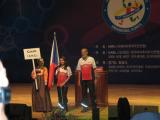 |
Czech Republic, or as the Koreans apparently still call it, "Czecho", was one of the top three competitive teams this year. |
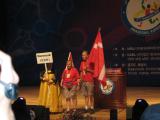 |
Team Denmark was a husband and wife team, Villy Hansen OZ6KH and Anette Hansen OZ1BCC. |
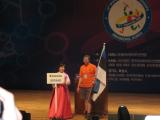 |
Team Estonia was a three-man team, but only one made the bus trip to the opening ceremony. |
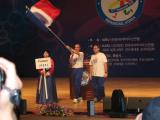 |
Most of the members of Team France came from the southern part of the country. |
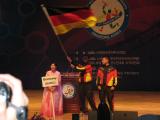 |
Germany would win several individual and team medals on 144 MHz. |
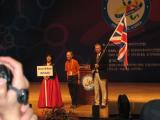 |
Robert Vickers G3ORI (left) and David Williams M3WDD (right) were the only two competitors from Great Britain. David would finish in 6th place in the 144 MHz M40 (men, ages 40 and older) category and 12th place in the 3.5 MHz M40 (men, ages 40 and older) category. |
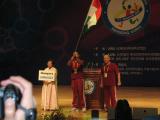 |
Team Hungary would do well, especially in the W35 (women, ages 35 and older) category. |
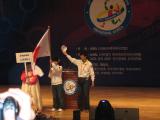 |
Japan brought a very large delegation to the championships, including 26 competitors. |
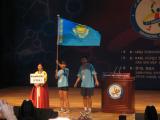 |
Team Kazakhstan had its best success in the W19 (women, ages 19 and younger) and M19 (men, ages 19 and younger) category. |
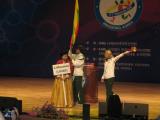 |
Lithuania brought four competitors to Korea and took home a medal in the M19 category on 144 MHz. |
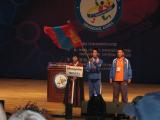 |
Despite some last-minute uncertainty regarding visas, Team Mongolia arrived with 16 competitors. |
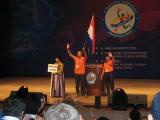 |
Team Netherlands was delighted that the official shirt for the championships (which both team members in this photo are wearing) was solid orange. |
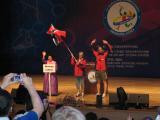 |
Norway sent seven competitors, all of them licensed amateur radio operators. Norway would win a team silver for M40 (men, ages 40 and older) on 144 MHz. |
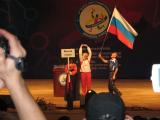 |
Russia is one of the three dominant teams in international ARDF competitions. Russia sent the maximum 27 competitors to the championships. |
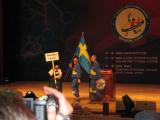 |
Team Sweden was composed of veterans. Five of the team members were over 60 years old, so two had to compete in the younger age categories because each country is allowed a maximum of three entries in each category. |
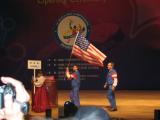 |
Jay Thompson W6JAY and Jay Hennigan WB6RDV took the stage for Team USA. They were chosen at the last minute mainly because they were wearing the uniform that Team USA got several years ago (which is no longer available). |
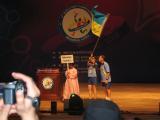 |
The Ukraine was another dominant nation at the championships. They were also the most enthusiastic about chants and songs to raise team spirit. |
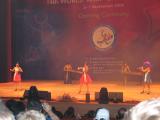 |
Following the parade of nations, there were more performances, including this University of Suwon student music group, called A Minor, that used traditional Korean instruments, a violin, and electronic background music. They had fog machines and flame machines on stage as well, and were later joined by dancers. It was an impressive show. |
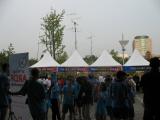 |
Outside the performance hall, the organizers had prepared several tents of information for the press and public as well as a special event station with separate tents for phone and CW operations. You can see a variety of antennas set up, including a four-bay of quad antennas for 144 MHz on an az-el rotor. |
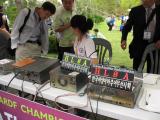 |
The phone station at the special event tents was apparently using the call sign HL0A. |
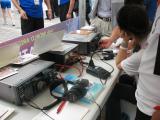 |
The radios were mostly older Kenwoods. |
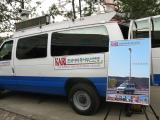 |
An emergency communications van equipped with amateur radio gear. |
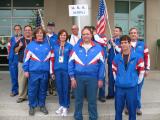 |
Team USA, standing on the steps in front of the university performance hall. |
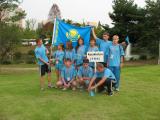 |
Team Kazakhstan, out on the lawn in front of the performance hall. |
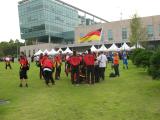 |
Team Germany gathering on the lawn. The performance hall building had a very modern style to it. |
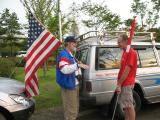 |
Dale Hunt WB6BYU and Villy Hansen OZ6KH. The flag that Dale is carrying is one he brought with him to Korea - it has travelled with Team USA to every World Championships that the USA has been to. |
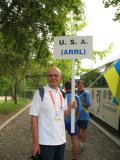 |
Harley Leach KI7XF somehow ended up with the USA sign. We don't know what happened to the nice, older woman who carried it across the stage for us - Harley wouldn't tell us. |
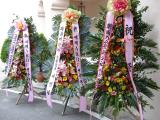 |
Later, the flowers arrived at the hotel, where they'd stay for the duration of the championships. |
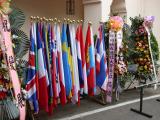 |
The floral arrangements and all the national flags. |
Friday, September 4 was the 144 MHz competition day. On both competition days, Jen and I took different paths. As a juror, I had an earlier breakfast and left for the competition area in a car with other jurors. My job was focused on one of the five transmitters, MOH (transmitter number four, the one Jen did not have to find because of the entry category she was running in). After set up, I observed the runners during the competition, recorded bib numbers as a backup in case of electronic punch failure, and recorded anything out of the ordinary. After the course was closed, I met with the other jurors to consider any disputes and approve the results. As a competitor, Jen traveled to the start area, ran the course, and then was able to return to the hotel hours before I could.
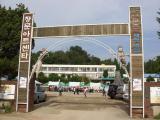 |
The waiting area at the start was apparently a playground for an elementary school or preschool. |
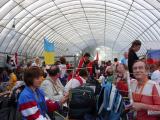 |
Arrival at the start. All competitors had to place their receivers in impound before the transmitters were turned on so that nobody could use them to get bearings before their start time. |
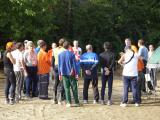 |
Team leaders and the jurors at the start area gather for last-minute procedural information and to receive the final version of the start list. |
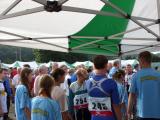 |
Some of the competitors already have their bib numbers attached to their jerseys. |
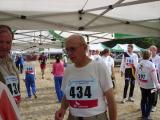 |
Harley Leach KI7XF of Team USA. Harley ran in the M60 (men, ages 60 and older) category. |
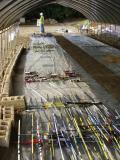 |
The impound area is full of 144 MHz receivers. One of the complaints during the team leader meeting after the event was that every country was allocated equal space on the tarps even though some countries had large teams and others only had a few runners. |
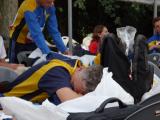 |
With so many competitors, and starts occurring at five minute intervals, the start times were spread over a three hour window of time. This Ukrainian competitor rests up waiting for his start. |
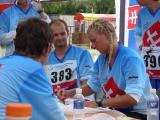 |
Team Slovakia reviews the start list. |
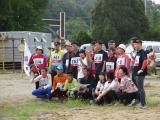 |
Team Korea, at the start. Korea was one of many teams that did not have national team uniforms. |
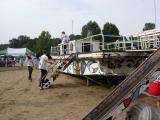 |
Some of the competitors check out the playground equipment. |
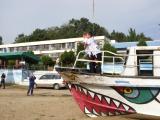 |
This old boat is a long way from the sea. |
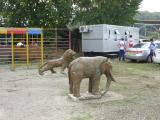 |
Some concrete animals. |
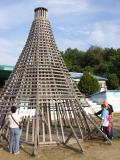 |
This was apparently part of the play equipment as well. |
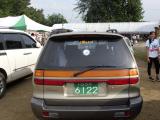 |
This Hyundai Santamo station wagon has an "I ♥ ARDF" sticker on the rear window. |
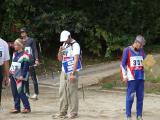 |
A group of competitors has retrieved their receivers and are waiting for the signal to move to the next step in the start process. In the center of the photo is Harley Leach KI7XF, adjusting his hydration system. Surprisingly, few competitors seemed prepared to carry their own water on course. |
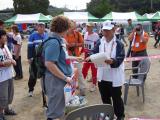 |
Jen Harker W5JEN is called up to collect her receiver. Like Harley, she's wearing a Camelbak hydration system. She carried about a liter and a half of water into the field. |
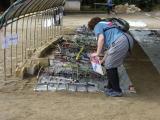 |
Jen finds her receiver in the impound area. |
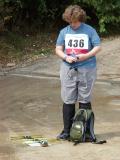 |
Jen gets her equipment in order. |
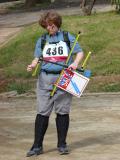 |
The tape measure yagi can be folded up for storage or transport. |
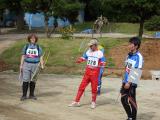 |
Jen is ready to go. The man in red is Fumio Takahashi JK1HMZ from Japan. Behind him is Vasyl Romamenko UT5UAD of Ukraine. The runner on the right is Mijiddorj Munkhbaatar of Mongolia. |
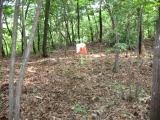 |
Transmitter location four (MOH) about an hour before the first runner arrives. The transmitter location was surrounded by moderately thick woods about 200 meters from a trail junction. |
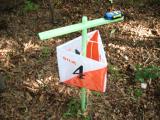 |
The control flag and electronic punch at transmitter number four. |
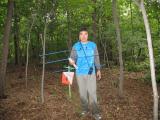 |
The transmitter operator at my control was Yoo Dong Gul DS4OMS. Yoo was in charge of setting up the transmitter and doing any troubleshooting necessary with the equipment during the competition. We brought my RF-2D 144 MHz receiver to be able to verify that we could hear all the transmitters from our location. Yoo's trousers are wet because we had to walk through some meadows with heavy morning dew to get to our patch of woods. |
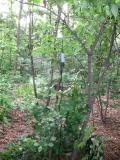 |
The transmitter antenna was a turnstile for 144 MHz. Two dipoles are fed with the proper phase shift to ensure an omnidirectional, horizontally-polarized signal. |
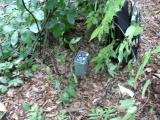 |
The transmitter was a MyKit FTX-280A. It had both a 144 MHz and a 3.5 MHz transmitter in it. The 144 MHz transmitter could be set to any frequency by dip switch, and transmitted in keyed AM (A2A). |
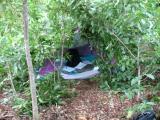 |
Yoo brought a tent with him for us to sit in during the six or seven hours of the competition. It was purple and cyan, which required a certain amount of effort to camouflage. |
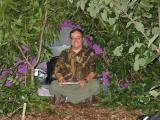 |
My job was to observe the control area. I had to record the bib numbers of runners as they punched in at the control as a backup in case of failures in the electronic scoring system. |
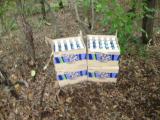 |
On the 144 MHz competition day, we were provisioned with 80 half-liter bottles of water for competitors. We went through about 70 of these bottles before the competition was over. |
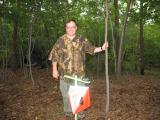 |
Me, standing next to the control a few minutes before the first start. The yellow bracelet I'm wearing is supposed to be a bug repellant. |
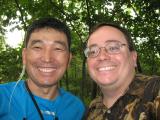 |
Yoo and me. |
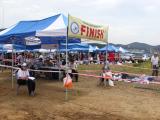 |
The finish line at the 144 MHz competition. |
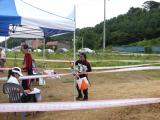 |
A runner arriving at the finish line, placing her SportIdent punch into the control device. |
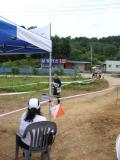 |
Jay Thompson W6JAY runs to the finish. Jay finished 37th in the M21 (men, any age) category. |
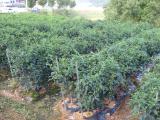 |
Some chili plants near the finish area. Small garden plots of chili peppers were scattered all over Korea. |
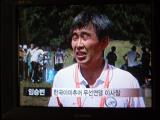 |
Later that evening, the competition made the television news. This is Han Jeong Hoon HL2AGG, the President of KARL. |
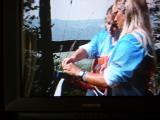 |
Two members of team Slovakia in the finish area, as seen on television. |
The 3.5 MHz competition was held on Saturday, September 6. The start area was a kind of park next to a small farm, and the finish area was an area used for military training and shooting (a different one from where the practice day was held). Compared to the 144 MHz competition, the terrain for the 3.5 MHz competition was much more challenging. A small mountain filled the central portion of the map, and the courses were set for longer distances than the previous competition.
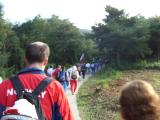 |
The start area for the 3.5 MHz competition was a moderate walk on a very narrow country road from where the buses dropped off the competitors. |
 |
A rice paddy. Rice was growing at various stages of development, from recently transplanted to ready to harvest, throughout the area. |
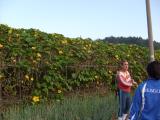 |
A fence line covered in pumpkin or squash vines. We even saw a few houses in the country with pumpkins growing on the ceramic tile roofs. |
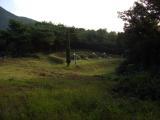 |
A gravesite. Graves were scattered throughout the competition areas both days. This was the weekend before the Chuseok holiday, which involves visits to gravesites of family ancestors, so the grass and weeds around the graves have been trimmed back. We did not see any modern graveyards in Korea; the majority today apparently opt for cremation. |
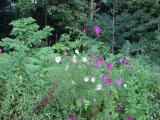 |
Some flowers on the side of the country road. |
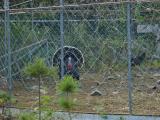 |
Turkeys on the farm near the start area. There was another cage next to this one with ducks. |
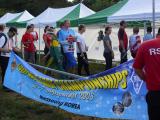 |
Competitors file into the impound area as two Korean volunteers set up one of the competition banners. |
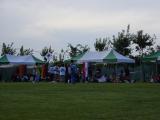 |
The teams that got to the start area early got to claim the most tent space. |
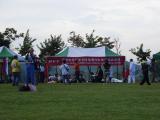 |
Team China brought banner with them that read "HYT wishes Chinese ARDF team achieve outstanding results!" |
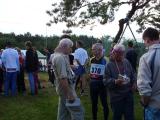 |
Some competitors mingling at the start area. Although some are wearing sweatshirts, the outdoor temperature was probably already warmer than 70°F. |
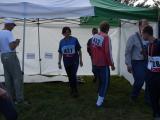 |
Some members of Team USA. On the left, in the white shirt and white cap is Harley Leach KI7XF (M60) from Montana. Number 437 is Nadia Scharlau (W35) from North Carolina. Wearing bib number 432 is Jay Hennigan (M50) from California. Behind Jay is Vadim Afonkin (M40) from Massachusetts. Number 428 is Jay Thompson W6JAY (M21) from California, and behind him is Scott Moore KF6IKO (M40), also from California. |
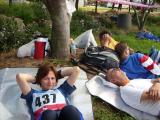 |
Nadia Scharlau and other members of Team USA relax at the start area waiting for their turns to be called up to start. |
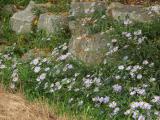 |
Some wildflowers near the start waiting area. |
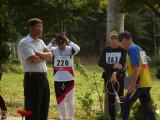 |
A group of runners has just retrieved their receivers from impound. |
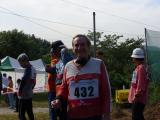 |
Jay Hennigan WB6RDV. |
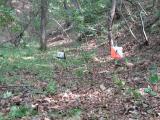 |
Transmitter number 4 (MOH) about an hour before the first start. Our location was in a broad spot in a gully formed by a normally dry stream. We were given one box (20 bottles) of water for runners to take. This proved to be woefully inadequate. |
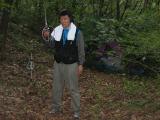 |
Yoo Dong Gul DS4OMS was the transmitter operator at my location again. Here he is using my Altai 3,5 receiver to see if we can hear our transmitter and the other transmitters as well. Transmitter 2 was not on when we first listened, but came on during the next cycle. |
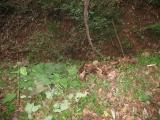 |
The transmitter and antenna at MOH. The transmitter is the same MyKit FTX-280A transmitter that we used two days before. For an 80 meter antenna, it uses a single vertical wire, that Yoo was able to hang up about six and a half meters in a tree, and a single counterpoise to a ground rod. The transmitter has a matching network in it and a tune indicator to match the random length wires. On 80 meters, the transmitter is A1A (keyed CW). The transmitter in this photo is completely hidden under a bunch of bright green leaves. |
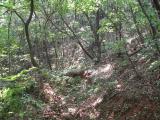 |
A look downstream from our location. About half of the competitors that arrived at our location did so by walking up the gully from below. |
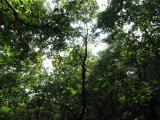 |
The forest overhead at transmitter location 4. |
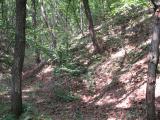 |
Looking upstream from the transmitter location. The sides of the gully were moderately steep. Maybe half of the competitors to arrive at the control approached it by walking along the top of the ridge on one side or the other and came down the sides of the gully directly to the flag. |
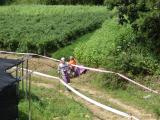 |
Artyom Avdeyev (M19) from Kazakhstan runs for the finish line through the taped finish corridor. The field behind him was growing chili peppers. Artyom came in third place, finding four transmitters and the finish beacon in just 74 minutes, 9 seconds. |
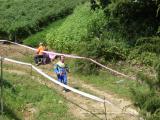 |
Syuichi Nishiuchi JA7EWX (M50) from Japan in the finish corridor. He is using a receiver based on a ferrite rod antenna design. He finished in 31st place in his category. |
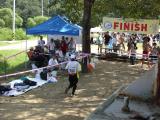 |
Galina Koroleva (W50) from Russia arrives at the finish line. She finished in seventh place. |
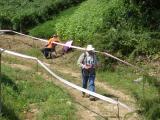 |
Scott Moore KF6IKO (M40) of Team USA at the finish. Scott found two transmitters, but finished over an hour overtime. |
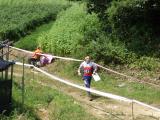 |
Jan Vlček (M19) from the Czech Republic in the finish corridor. Jan came in fifth place. |
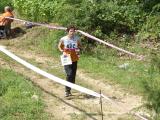 |
Charles Scharlau NZ0I (M40) from Team USA runs in. Charles found three transmitters, but finished 37 minutes overtime. |
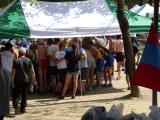 |
Competitors cluster around some laptops that are displaying preliminary times for those that had already finished. |
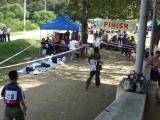 |
Two runners arrive at the finish line. Bib number 224 is Akihiro Sakaguchi JF6UXE (M40) from Japan. Akihiro found three transmitters, but finished about 40 minutes overtime. Bib number 123 is Xia Ziwen (M21) from China, who found three transmitters but finished seven minutes overtime. |
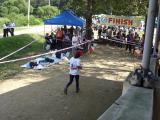 |
Wang Shuyan (W35) from China runs into the finish line. Wang came in 19th place in this competition, but won a silver medal in the 144 MHz competition two days before - the only medal won by the Chinese at this championships. |
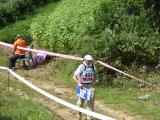 |
Harley Leach KI7XF (M60) of Team USA runs up the finish corridor. Harley found all of the transmitters required for his entry category. He finished in 25th place. |
The awards ceremonies were held in a lecture hall at the Suwon Science College next door to the La Vie d'Or hotel. These photos are all from the 144 MHz awards. The major difference between the 144 MHz award ceremony and the 3.5 MHz award ceremony was that there were fewer countries represented in the 3.5 MHz medal counts. After the 3.5 MHz competition award ceremony, the organizers hosted a party outside in the patio garden at the hotel.
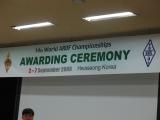 |
The banner above the small stage where the medalists would stand to receive their medals. |
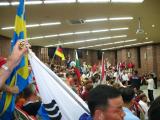 |
The lecture hall begins to fill up with competitors and national flags. |
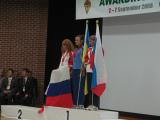 |
144 MHz medalists in W19 (women, ages 19 and younger) were #1 Oleksandra Parkhomenko of the Ukraine, #2 Ekaterina Filippova of Russia, and #3 Oxana Maximova of Russia. They found four transmitters in around 90 minutes each. |
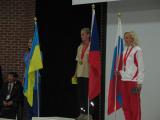 |
144 MHz medalists in W21 (women, any age) were #1 Veronika Krčálová of the Czech Republic, #2 Olena Fursa of the Ukraine, and #3 Tatiana Melnikova of Russia. These three countries dominated the medal places. |
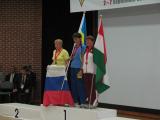 |
144 MHz medalists in W50 (women, ages 50 and older) were #1 Tetyana Parkhomenko of the Ukraine, #2 Galina Petrochkova of Russia, and #3 Marianne Fent of Hungary. All three required more than 100 minutes to find three transmitters. |
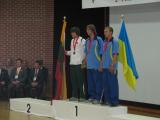 |
144 MHz medalists in M19 (men, ages 19 and younger) were #1 Maksym Lavryk of Ukraine, #2 Mindaugas Nakvosas of Lithuania, and #3 Egor Korotkov of Ukraine. This was the only individual medal won by Team Lithuania. |
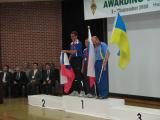 |
144 MHz medalists in M40 (men, ages 40 and older) were #1 Baktybek Sharshenov of Russia, #2 Sergey Gureev RU6FG of Russia, and #3 Mykhailo Pugach of Ukraine. |
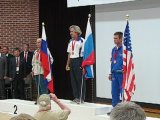 |
144 MHz medalists in M50 (men, ages 50 and older) were #1 Igor Kekin of
Russia, #2 Stanko Čufer S57CD of Slovenia, and #3 George Neal KF6YKN of the United States of America. [VIDEO] |
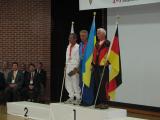 |
144 MHz medalists in M60 (men, ages 60 and older) were #1 Oleg Fursa UR4URL of Ukraine, #2 Yoshimi Kaneshige JR1CHU of Japan, and #3 Manfred Platzek of Germany. This was the only individual medal won by the Japanese team. |
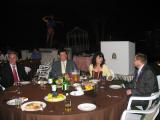 |
A garden party at the hotel followed the 3.5 MHz awards ceremony. Panayot Danev LZ1US, an international juror from Bulgaria (far left) and Ole Garpestad LA2RR, the president of IARU Region I and an international juror from Norway (far right) are dining with two of the Korean organizers. Every table at the party had endless beer and soju. |
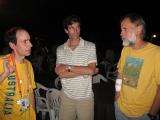 |
Bryan Ackerley VK3YNG (M40), Charles Scharlau NZ0I (M40), and Bob Cooley KF6VSE (M60) at the after-event party. Bob injured his arm during the 3.5 MHz competition. Nonetheless, Bob finished in seventh place, less than 12 minutes out of third place, the third-best finish for an American at this World Championships. |
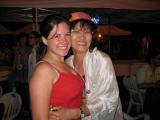 |
Amelie Nespoulous (W21) of Montpellier, France and Thida Denpruektham HS1ASC, of Bangkok, Thailand. Amelie came in 20th place in 144 MHz and 22nd place in 3.5 MHz. |
|
Last Updated 26 June 2020 wm5r@wm5r.org |